By
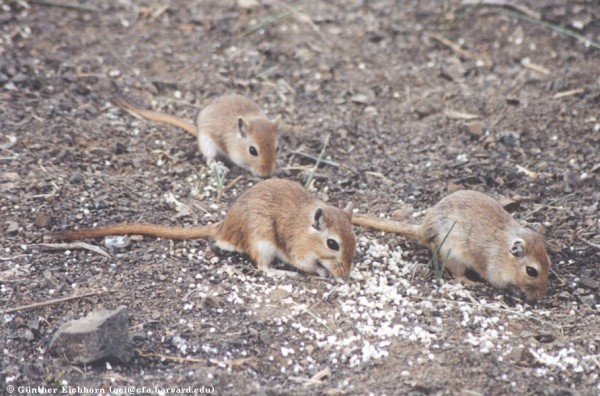
This picture of Mongolian Gerbils, was taken in the wild in
Mongolia. Click for a larger version.
Used by permission of Dr.
GŁnther Eichhorn. Visit his website
for some great nature photos of Mongolia (and other locations).
Click here for some more of GŁnther's wild
gerbil pictures, and some pictures of wild gerbils now in captivity.
(The rest of the pictures on this page are of regions of the Gobi
Desert and are typical of the sort of places you would expect to find Gerbils.)
The following information on gerbils in the wild is taken exclusively from:
- G. Agren, Zhou Q & Zhong W. 1989. Ecology and social behaviour
of Mongolian gerbils, Meriones unguiculatus, at
Xilinhot, Inner Mongolia, China. Animal Behaviour, 37, 11-27.
- Abstract. Observations were made of social and territorial
behaviour in a wild high-density population of Mongolian
gerbils. The social units were multi-male, multi-female age-structured
groups, judged to be families. The operational sex ratio was male biased.
Group size varied from two to about 17 animals. Non- overlapping territories
were defined by a clustered distribution of burrows, by common areas of
activity of group members, and by chases across border zones between the
areas used by each group. Territory size was correlated with group size, and
ranged from 325 to 1550 m2. Within groups, differential social
status was indicated by behaviour patterns of dominant as well as
subordinate character. Larger individuals dominated smaller ones, and males
usually dominated females. Males ranged more widely and they were generally
more active than females. The rate of sexual maturation in subadults varied
according to group composition. Mainly the largest reproductively active
males defended the territories by chasing, and also by marking along
borders. An increased marking rate was observed in reproductively active
males and females during oestrus. Three females were observed to copulate,
two with more than one male. One female preferentially copulated with a
neighbouring male. The functions of territorial defence, marking behaviour
and promiscuous mating are discussed, and some cross-species comparisons are
made. The present observations are to a large extent compatible with the
results of relevant laboratory and seminatural studies.
Mongolian Gerbils were observed in the wild in the
Xilinhot area of Inner Mongolia (44N, 116E) at 1100m above see level. The area
is typical steppe with a sandy soil and a sparse covering of grass, herbs and
shrub. Precipitation falls mainly as rain from June to August and snow from
October to April. In 1983, the year before the observations the total rainfall
was 228.9mm. The winter before the observations there had been a total of 60
days of snow cover with the longest single period being 20 days. The annual mean
temperature in the region is 1.7C with a monthly mean of -19.8C in January and
+20.8C in July. Temperatures can reach -40C in winter and +50C in summer. The
Xilinhot area is representative of the Mongolian Gerbil's
preferred habitat.
The observations, which were made in June 1984, were restricted to an area
175m x 50m along a small track with the movement of animals reported against a
grid marked out by flags. Initially traps were set and the animals caught were
weighed, their fur was clipped to enable identification from a distance and the
animals were examined for pregnancy, lactation, sexual maturity, development of
the scent gland etc. It was estimated from the low number of unmarked animals
subsequently seen that almost all the population of the area was successfully
trapped. Subsequent observations were made in the morning and in the evening
which coincided with peak activity above ground.
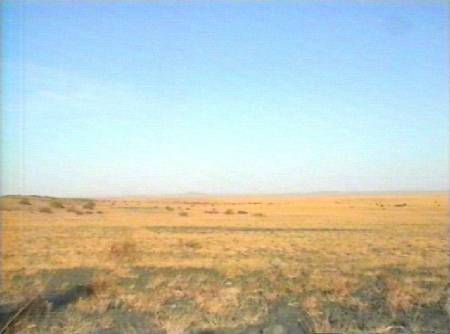 Gerbils were seen feeding mainly on the Mugwort Artemisia sieversiana,
although A. commutata, Salsola collina, a Saltwort, Setaria viridis, a Bristle
Grass and the Lyme Grass Leymus chinensis were also eaten. Gerbils were seen
foraging in barren areas and it was assumed that they were feeding on seeds.
Gerbils dug whilst feeding and might have been also eating roots. Although not
mentioned in the article it is possible they were seeking invertebrates. The
remains of two winter food stores were discovered and both consisted entirely of
the seed husks of L chinensis. Interestingly the dried plant sold as Millet
Sprays for Budgerigars in UK petshops is a Bristle Grass. As an experiment I
gave some to four pet gerbils who devoured the entire spray in minutes.
Gerbils were seen feeding mainly on the Mugwort Artemisia sieversiana,
although A. commutata, Salsola collina, a Saltwort, Setaria viridis, a Bristle
Grass and the Lyme Grass Leymus chinensis were also eaten. Gerbils were seen
foraging in barren areas and it was assumed that they were feeding on seeds.
Gerbils dug whilst feeding and might have been also eating roots. Although not
mentioned in the article it is possible they were seeking invertebrates. The
remains of two winter food stores were discovered and both consisted entirely of
the seed husks of L chinensis. Interestingly the dried plant sold as Millet
Sprays for Budgerigars in UK petshops is a Bristle Grass. As an experiment I
gave some to four pet gerbils who devoured the entire spray in minutes.
Weasels were seen in the area and fled to gerbil burrows when disturbed.
Gerbil activity was very much reduced for some days afterwards in the areas
where these animals were observed. Buzzards were seen every day but there was no
sign of preying on gerbils. The Eagle Owl is
the only owl native to the area and all owl pellets examined contained only
gerbil remains. Other local predators which were not observed are foxes, wolves,
and sheep dogs.
The only observed competitor was a single female Ground Squirrel
(Spermophilus dauricus) but the Daurian Pika (Ochotona daurica,) and Daurian
Dwarf Hamster (Cricetulus barbabensis, a close relative of the Chinese Dwarf
Hamster) also live in the area. Gerbils and the ground squirrel were seen to
respond to one another's warning signals. Gerbils responded to the squirrel's
warning whistles and the Citellus reciprocated when gerbils gave foot thumping
warnings.
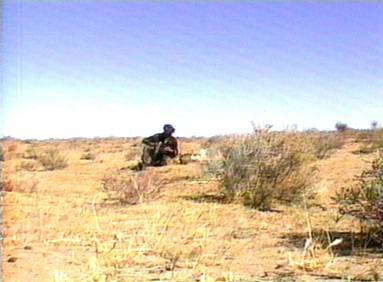 From
trapping and observations it was determined that the average population ranged
from 42 to 90.6 gerbils per hectare dependent on vegetation growth. Of the 126
gerbils caught 19% were juveniles, 54% subadults and 27% adults. Only 4% of the
adults were likely to be aged at least 8 months old. Males made up 42% of
juveniles, 58% of subadults and 68% of adults. At the time of the study (June
1984) 9 of the 11 adult females were either pregnant or lactating.
From
trapping and observations it was determined that the average population ranged
from 42 to 90.6 gerbils per hectare dependent on vegetation growth. Of the 126
gerbils caught 19% were juveniles, 54% subadults and 27% adults. Only 4% of the
adults were likely to be aged at least 8 months old. Males made up 42% of
juveniles, 58% of subadults and 68% of adults. At the time of the study (June
1984) 9 of the 11 adult females were either pregnant or lactating.
Burrows took the form either of 10-20 irregularly spaced entrances that were
likely to form a single burrow system or of a more shallow burrow with 1-3
entrances located some distance from the main burrow. The manner in which the
same gerbils were repeatedly trapped in the same areas associated with burrow
entrances allowed the social groupings of the gerbils to be identified. By
observing that the borders of the ranges were marked by chasing behaviour
between rival adults (mainly males) it was possible to identify the territory
belonging to each social group. Chasing and scent marking were the main forms of
territorial behaviour.
The territory belonging to each group ranged from 325 to 1550m2
depending on group size, food availability and most importantly the body weight
of the largest male gerbil.
Groups consisted of up to 17 individuals. A typical group had on adult male
and an adult female living with up to 3 litters of offspring.
![[Picture]](images/gobi4.jpg) Within
the territory of each group the dominant male was the only gerbil the usually
used anything like the whole area. Juveniles rarely strayed far from the burrow
entrances and on average females ranged over a much smaller area than comparable
males. Where there was no dominant male the younger males ranged over a large
area.
Within
the territory of each group the dominant male was the only gerbil the usually
used anything like the whole area. Juveniles rarely strayed far from the burrow
entrances and on average females ranged over a much smaller area than comparable
males. Where there was no dominant male the younger males ranged over a large
area.
Females were seen copulating three times. In two of these cases the female
was seen to copulate with at least two different partners immediately after one
another. In at least one of these cases the female mated with both the dominant
male from her burrow and a subordinate male from an adjacent territory. A male
partner was seen collecting nesting material on 13 occasions on two and three
days before mating took place. Females were only once seen collecting nesting
material.
There is plenty more in this paper which I would recommend to anyone with an
interest in Mongolian Gerbils.

Here are some more of GŁnther Eichhorn's
pictures of wild gerbils -
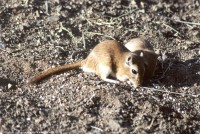
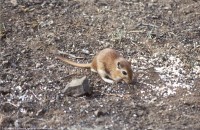
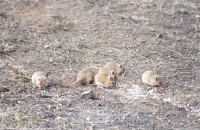
In Europe there are some gerbils that are completely descended from gerbils
caught in Mongolia in about 1995. These gerbils have different characteristics
to those normally kept. For example, they are less easy to handle, have longer,
narrower heads, their eyes are larger and the most obvious feature, their ears
are darker, longer, more pointed and carried further back on the head. Less
obviously, the feet are darker and their is much more yellow on the belly.
Additionally, their fur is thicker and the tail tuft is more prominent.
The differences are no doubt in part due to human selection as gerbils have
been kept as pets for over 40 years, but it is possible the there are
differences between different wild populations of Mongolian Gerbils.
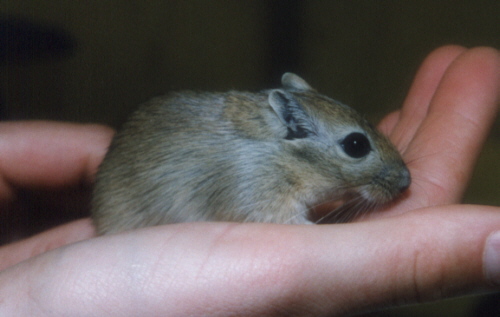
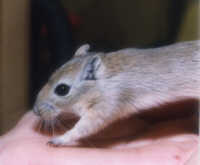
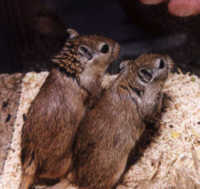
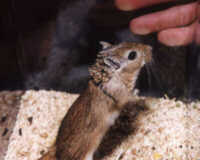

Click here for more
information on Mongolian Gerbils living in the wild.
If anyone encounters scientific papers on gerbil behaviour, or natural
observations of other species of gerbil or jird, .



Return to the NGS Homepage?
The views presented on this page are not necessarily those of the National
Gerbil Society.
Please note that the material on these webpages is covered by copyright law.
If you wish to use any pictures etc for anything other than your personal
private use, such as publishing material on a website, then
This web page may include links to other web sites. These links are provided
in order to enhance the interest and usefulness of other content and are not
intended to signify that the National Gerbil Society, or the authors of material
featured on the NGS Website, endorses or otherwise has any responsibility for
the content of any linked web page, web site or other linked material.
This page has been constructed by
Telephone number for media contact only - (+44)
07941893143

Last updated 22 November 2013


![[Picture]](images/gobi1.jpg)
 Gerbils were seen feeding mainly on the Mugwort Artemisia sieversiana,
although A. commutata, Salsola collina, a Saltwort, Setaria viridis, a Bristle
Grass and the Lyme Grass Leymus chinensis were also eaten. Gerbils were seen
foraging in barren areas and it was assumed that they were feeding on seeds.
Gerbils dug whilst feeding and might have been also eating roots. Although not
mentioned in the article it is possible they were seeking invertebrates. The
remains of two winter food stores were discovered and both consisted entirely of
the seed husks of L chinensis. Interestingly the dried plant sold as Millet
Sprays for Budgerigars in UK petshops is a Bristle Grass. As an experiment I
gave some to four pet gerbils who devoured the entire spray in minutes.
Gerbils were seen feeding mainly on the Mugwort Artemisia sieversiana,
although A. commutata, Salsola collina, a Saltwort, Setaria viridis, a Bristle
Grass and the Lyme Grass Leymus chinensis were also eaten. Gerbils were seen
foraging in barren areas and it was assumed that they were feeding on seeds.
Gerbils dug whilst feeding and might have been also eating roots. Although not
mentioned in the article it is possible they were seeking invertebrates. The
remains of two winter food stores were discovered and both consisted entirely of
the seed husks of L chinensis. Interestingly the dried plant sold as Millet
Sprays for Budgerigars in UK petshops is a Bristle Grass. As an experiment I
gave some to four pet gerbils who devoured the entire spray in minutes. From
trapping and observations it was determined that the average population ranged
from 42 to 90.6 gerbils per hectare dependent on vegetation growth. Of the 126
gerbils caught 19% were juveniles, 54% subadults and 27% adults. Only 4% of the
adults were likely to be aged at least 8 months old. Males made up 42% of
juveniles, 58% of subadults and 68% of adults. At the time of the study (June
1984) 9 of the 11 adult females were either pregnant or lactating.
From
trapping and observations it was determined that the average population ranged
from 42 to 90.6 gerbils per hectare dependent on vegetation growth. Of the 126
gerbils caught 19% were juveniles, 54% subadults and 27% adults. Only 4% of the
adults were likely to be aged at least 8 months old. Males made up 42% of
juveniles, 58% of subadults and 68% of adults. At the time of the study (June
1984) 9 of the 11 adult females were either pregnant or lactating.![[Picture]](images/gobi4.jpg) Within
the territory of each group the dominant male was the only gerbil the usually
used anything like the whole area. Juveniles rarely strayed far from the burrow
entrances and on average females ranged over a much smaller area than comparable
males. Where there was no dominant male the younger males ranged over a large
area.
Within
the territory of each group the dominant male was the only gerbil the usually
used anything like the whole area. Juveniles rarely strayed far from the burrow
entrances and on average females ranged over a much smaller area than comparable
males. Where there was no dominant male the younger males ranged over a large
area.





